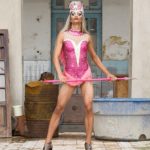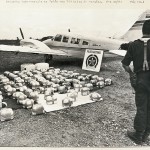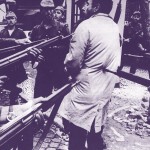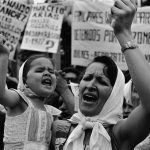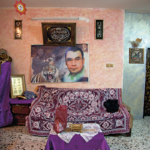Understanding through photography
Publicado em: 24 de March de 2020
Painéis dedicados ao poeta romano Ovídio (43 a.C.-18 d.C.), organizados pelo historiador da arte Aby Warburg (1866-1929). Warburg notabilizou-se pela elaboração do Atlas Mnemosyne, conjunto de 63 painéis com cerca de mil imagens relacionadas por uma lógica iconográfica independente da expressão verbal. Instituto Warburg, Londres, 1927.

Exposição Atlas: como carregar o mundo nas costas?, organizada por Georges Didi-Huberman em Hamburgo. Foto de Arno Gisinger, 2011.
Arno Gisinger: From the end of the 19th century, the great art historians, such as Heinrich Wölfflin, considered it normal to include photography in their research and teaching practices. But, above all, it is Aby Warburg’s famous Mnemosyne Atlas which places photography in the center of a new way of thinking, a new methodology used in art history. When did you start working with Warburg?
Georges Didi-huberman: I started working with Warburg in 1984, when I was living in Italy: it was an unexpected tool to explore issues that seemed to me to be ignored by the Anglo-Saxon iconographical tradition and by its structuralist reinterpretation in France. At first, I read Warburg when I was researching the Italian Renaissance; indeed, I found him via an Italian translation. An important article by Giorgio Agamben entitled “Aby Warburg and the Nameless Science” was also published in 1984, in Rome, where I was living at the time. I had the fortunate opportunity to discuss it with Agamben, as well as his Warburgian book Stanzas: Word and Phantasm in Western Culture.
At the time, the Mnemosyne Atlas was not the focus of my concerns. Warburg’s work brought me closer to a historical anthropological view of western images, in which the unconscious – or, rather, symptom and survival – played a fundamental role. In fact, only after I returned to France, and also during the periods I spent researching at the Warburg Institute in London, did I understand the crucial role of Mnemosyne, which was to be published formally.
A not surprising interest: as you know, my starting point was a reflection on the use of photography in the clinical study of hysteria in the 19th century, i.e. from a reflection situated on the meeting point between an aesthetic and an epistemology. Mnemosyne was, at once, the invention of a form and the invention of an uncommon anthropological and historical knowledge. It then resulted in this reflection on the atlas of images and, later, the exhibition Atlas at the Reina Sofía Museum in Madrid in 2010, which afterwards went on to be shown in Karlsruhe and Hamburg, where you photographed it.

No livro Invenção da histeria, Georges Didi-Huberman estudou a relação entre a psiquiatria e a fotografia no século 19 a partir do material iconográfico produzido pelo hospital da Salpêtrière, em Paris, que abrigava mulheres consideradas loucas ou incuráveis. Sob a direção do médico Jean-Martin Charcot, a fotografia era usada como prova controversa da histeria feminina. Fotografia do livro Iconographique photographique de la Salpêtrière (1876-1877), de Bourneville e Régnard.
In your book, Invention of Hysteria, you de- construct the (incorrect) uses to which photography is put: the medical iconography in the Salpêtrière Hospital in Paris, for example. What did it mean to raise this question in the history of art and photography in the early 1980s?
At the time, I was not concerned with determining the issue of the disciplinary field, as indeed, I never worry about that from the beginning, because the object of the research requires me to move continually between different disciplines. “Discipline”: what a beautiful word, if in it we hear the Latin word discere, which means “to learn,” as opposed to docere, which means “to teach!”. And what an ugly word it is if we hear in it obedience to rules of thought! I studied the Salpêtrière photographs for a very simple reason: they fascinated me. Or rather, it was not for a simple rea- son… because my fascination with those images came with the perception that something was out of place, something that appeared without becoming completely clear. What I noticed in those images was the trace of a fundamental pain.
Therefore, well before the deepening of the Warburgian concept of pathosformel or “pathos formula,” I dedicated myself to the question of the link between image and pain. In fact, it would be more correct to employ the plural in both cases, “images” and “pains,” as in the beautiful name Dolores: images of the dolors (pains), dolors of images.
The photographic iconography of hysteria opened up an original virgin, so to speak, field. In no time, the question became focused – thanks, especially, to the work of Michel Foucault on the history of the clinic – in the overlapping of medical and photographic protocols. Foucault leaned towards the relationship, always problematic, between discourses and practices. I didn’t do more than add the image, which is in an intermediate position, very effective for this purpose, between the discourses and the practices. The photo situation, of which I tried, before each image, to rebuild something similar to a phenomenology, became not only the creator of images, but also of knowledge, on the one hand, and symptoms on the other.
The pain of the body reappeared as a ghost in their photographic representation. What was disturbing, indeed, much more than a “history of photography” as a specific medium, was to observe how the visual medium functioned as an epistemic medium – a fact that seems obvious, but when examined closely, is rather complex – and also as a critical medium. On one hand, photography was involved in a certain policy, or policing, of the bodies in the 19th century, situated at some point between the inclusion of the hysterical body in a history of ancient art (via religious iconography) and its alienation in an institutional practice that was at the very least sexist and cruel. That is why, I believe, my book was so referenced in feminist criticism. But photography was not only an instrument of power: it also appeared as a widespread questioning of powers, of knowledge and of bodies.
Your contribution to the exhibition Memory of the Camps at the beginning of the 21st century triggered – or, more accurately, rekindled – the thorny issue of photography as evidence in the context of the representation of the Shoah. You responded to this controversy with the book Images in Spite of All, published in 2003. How do you see this debate now, fifteen years later?
The issue of proof – which photography has been stuck with since it began – had put the debate under false premises from the start. On one hand, the French filmmaker Claude Lanzmann used to say: if you feel the need of proof, for example, photographic, of the destruction of the Jews in Europe, it is because you are already in denial. On the other hand, it is evident that the members of the Sonderkommando [groups of Jewish prisoners forced to work under German officers in the extermination camps] in Auschwitz-Birkenau had assumed the risk – a huge risk – of taking photographs to present something that corresponded to the “visual proof” of a mass criminal act, the extent to which the whole world was ignorant of at the time, or wanted to ignore. But a photographic image is never this or that: it is just what one wants to do with it, either from the point of view of the person taking it or from the point of view of the person viewing it.
What troubled me in this extreme example was that, for the members of the Sonderkommando, the photographic image functioned as a decision of resistance – as part of a bigger movement to collect statements by witnesses and attempts at an uprising – and that this transformed the image into something that had nothing to do with information or representation: it was an act, and not a mere record, it meant taking a risk and it was a provocation, not just a proof. Fifteen years later, everything is at the same time different and the same: different, because my phenomenological analysis of the taking of the photograph is not, as far as I know, challenged; and identical, because it is very difficult when faced with an image not to want to derive from it a general principle, an “ontology.” The image is such a crucial question that everyone wants to know what it is, when the question should be knowing what makes this particular image, what it does that another image does not.

Georges Didi-Huberman dedicou o livro Imagens apesar de tudo às únicas quatro fotografias que documentam o processo de extermínio em massa conduzido nas câmaras de gás dos campos de concentração nazistas. As fotos mostram a queima de corpos e a entrada de mulheres na câmara do crematório 5 de Auschwitz. Tiradas às escondidas por um prisioneiro judeu forçado a participar das atrocidades, estas imagens são um ato de resistência, argumenta.
You showed the Sonderkommando photographs in the exhibition Uprisings. What was their significance in that context?
Visitors to the exhibition have once asked me: “How is it possible that in an exhibition on uprisings you include images of people who are going to their death without rebelling, or of corpses burning in front of the gas chambers?” And I was forced to reply: “Bear in mind that these people had absolutely no means of rising up in revolt, while the agent of the uprising was precisely, when we think of the Sonderkommando itself, the very image: the image as an act, I repeat, the photograph as an illegal act and not simply one representation. Look at what the image does, and not just what it represents.”
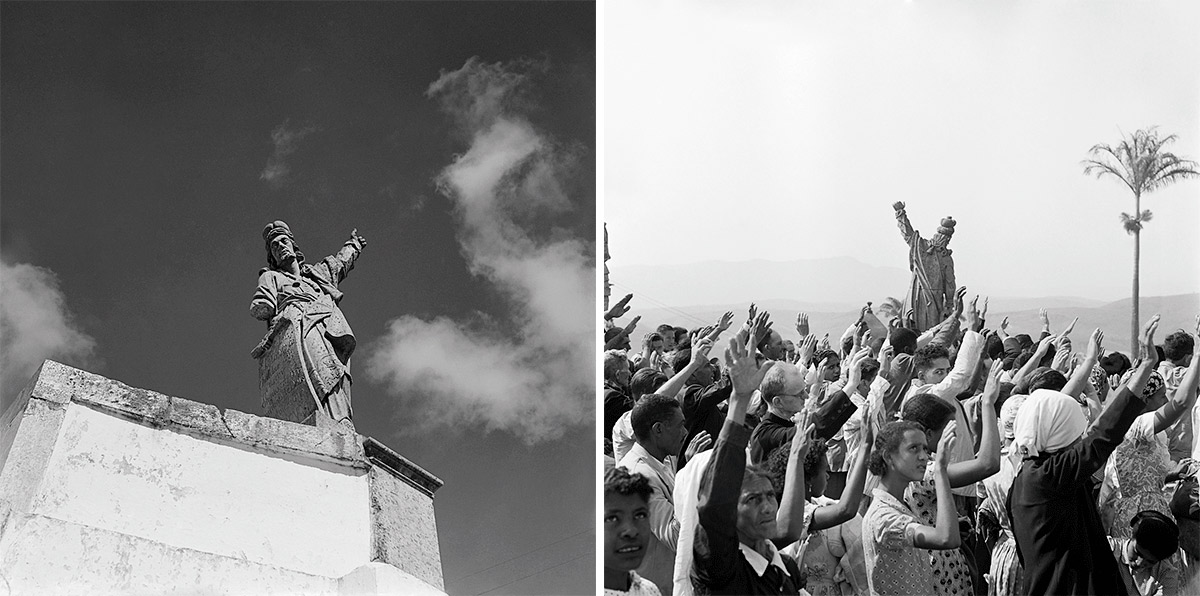
Estas fotografias feitas por Marcel Gautherot em Congonhas (antiga Congonhas do Campo), Minas Gerais, c. 1947, foram incluídas na exposição Levantes, organizada por Georges Didi-Huberman e inspirada na pesquisa visual dos gestos desenvolvida por Aby Warburg.
The camera is part of the work tools available to you as an art historian. When and how did you start to take photographs of works? Did you follow the “approach” of other art historians? Daniel Arasse, perhaps?
I need to refer to various moments. First: when I was researching into hysteria, between 1979 and 1981, I used the photograph to solve the difficulty of accessing documents. To sum it up, I’ll say that when it started to get dark, after a whole day researching in the Charcot library, I would take a volume of Photographic Iconography of the Salpêtrière with me – without permission, of course – and at night I would photograph it at home (I had bought a Czech repro stand, i.e., robust and cheap), and would return the book the following morning. All the images in my book Invention of Hysteria were obtained that way; I also happened to ask a professional photographer to help with reproducing the more difficult images. I used Tri-X 400 ASA black and white films. I sent them to be developed at the Publimod lab. I also took photographs in Paris, mainly at the Louvre – researching for a film project of mine I was developing with the filmmaker Jean-André Fieschi, always on the topic of hysteria.
A second moment: during a trip to Italy. I think I used the same Pentax camera from my first experiments, only this time with color slide film. It was then – after 1984 – that I saw how the photographic practice was important for a historian such as the Algerian Daniel Arasse, with whom, at the time, I used to talk a lot. This is because, unlike the American universities, for example, French institutions did not have slide libraries where images of art works could be mined. That’s why we made our own – and sometimes also for our friends Louis Marin or Hubert Damisch, who preferred to visit the Italian museums with their sketch books in hand.
The practice was both inconvenient and an advantage. It was inconvenient that we had to take – and sometimes “sneak” – photographs in poorly-lit locations, using natural or artificial light, which meant these photos did not have good quality. The advantage was that we took photographs that nobody before us had had the idea of taking. This is what happened with the “false marbles” of Fra Angelico’s frescoes in Florence. I started taking 35mm slides with my Pentax; then in order to publish an article on the magazine Mélanges de l’École Française de Rome in 1986, I asked the photographer Patrick Faigenbaum – who, like me, was a guest at the Villa Medici – to make some 6 × 6 slides with much better color than mine. To this day I still have those slides somewhere.
After 1986, I went to live in Florence while I was working at the Villa I Tatti, home of the famous art historian Bernard Berenson. In that institution I understood, in very concrete terms, that every practice of art history depended on options that were in principle linked to photographic reproductions. Berenson’s library of photographs is legendary, extraordinary, but in black and white, of course. It is dedicated exclusively to the figurative elements of Renaissance art. I had to take all the images of the “ornamental” areas which interested me at the time myself, with their iconological link to the “figures” – in fact, with a great and pleasurable feeling of exploration and discovery.
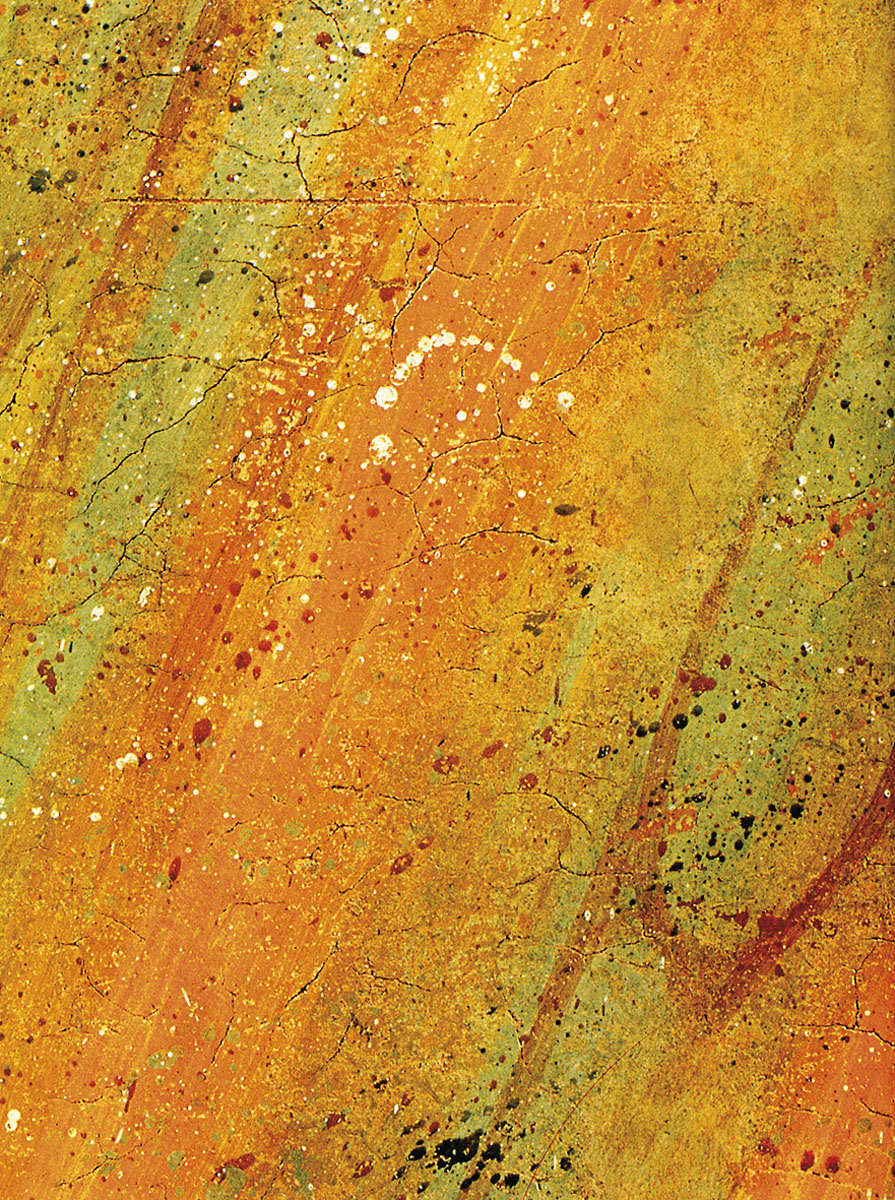
Desde os anos 1980, a fotografia foi usada por Didi-Huberman para reproduzir obras que não estavam disponíveis nos bancos de imagens das instituições francesas, como este “falso mármore”, detalhe do afresco Madona das sombras (c.1435), de Fra Angelico. Convento de San Marco, Florença. Foto de Georges Didi-Huberman, 1985.
A more general question: in what ways can the photographic camera be an instrument to support understanding?
This general question is, in fact, one that is fundamental, crucial: because it involves, in the research process, an extremely important decisive moment, a “crossroads” at the same time practical and theoretical, aesthetic and epistemic. What does it mean to “comprehend”? It literally means “to take with”. Therefore, take and bring to oneself. From this, it is clear that it is not possible, at any moment, to comprehend everything: what we bring to us is never more than a small portion of the world. In the visual field, what we “comprehend” is what we frame, cut: the part that we decided to bring to us. In the case of the Fra Angelico frescoes, my decision was simply to frame the bottom of the image, not only to look at the figurative area higher up, but also the “abstract” area beneath, and reflect on their relationships. Framing is, in this way, an option for knowledge, or rather, the choice of the question that you want to address to what is visible.
But framing is not an exact science. It is a heuristics, an experiment. Even intuitively, it does not always work. Sometimes, it happens that I frame something, return home, work with what I have framed – and everything else that comes with it: sources, texts, theoretical questions, comparisons –, and then have to go back to the beginning to make a more correct, more fruitful framing, in a certain way. It is a constant coming and going between framing, cutting, montaging, with one’s actions being put to the test through thought.
I can give you a Brazilian example, which you witnessed in Rio de Janeiro in 2013. Along with Tadeu Capistrano and other friends, we went for a stroll through the gardens of Parque Lage. I was thinking of Glauber Rocha, who had filmed Entranced Earth (1967) there. At the same time, I was walking between the roots that sprang up from every side beneath our feet, like large serpents. Fascinated, I photographed the roots and asked myself: “But, in the end, what does ‘radicalism’ mean, when the roots assume this form of intertwined serpents?” (a theoretical construct that I identified in Warburg, rightly, as being crucial). We can say, then, in this case and in many others, that the photographic act took place at the exact point when a sensual perception encountered a philosophical inquiry.
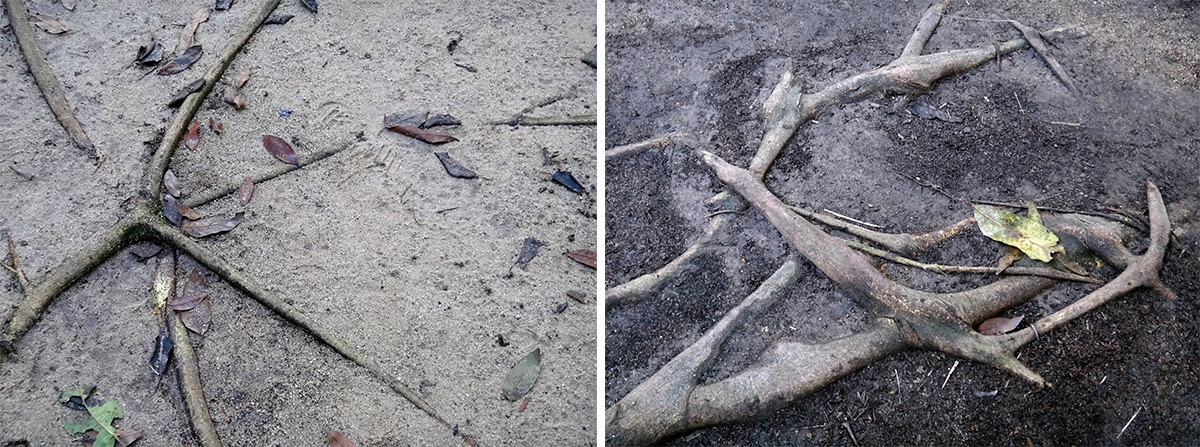
Enquanto passeava com amigos pelo parque Lage, no Rio de Janeiro, Didi-Huberman observou as raízes que brotavam como grandes serpentes. Fascinado, se perguntou: “Mas, afinal, o que significa ‘radicalidade’?”, e se deu conta de que, “nesse caso e em muitos outros, o ato fotográfico estava situado no exato ponto de encontro de uma percepção sensível com um questionamento filosófico”. Fotos de Georges Didi-Huberman, 2013.
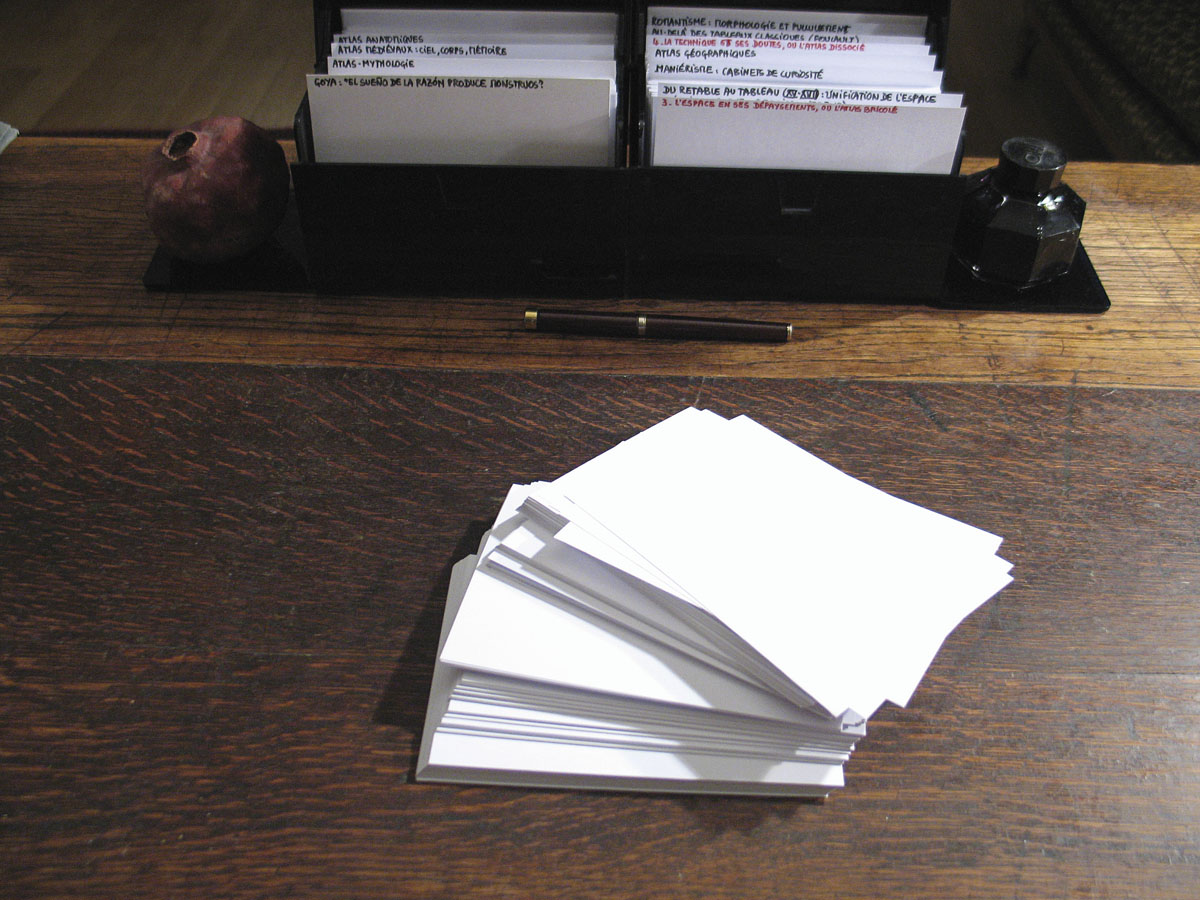
A escrita de Didi-Huberman se baseia num sistema de fichas, cuja produção se assemelha à prática fotográfica. Foto de Georges Didi-Huberman, 2009
Fotos de Auschwitz-Birkenau, campo de concentração onde Didi-Huberman perdeu familiares. As imagens fotográficas são um atestado da presença do historiador no local e a forma que encontrou de descrever a emoção da visita. Fotos de Georges Didi-Huberman, 2011.
What role do the photographic images have in your work system based on file cards and on the repro stand?
All my writing is based on a system of file cards in which the montage – in fact, here it follows the framing, the other determining procedure – generates thoughts, hypothesis, with their development and consequences, often unpredictable at the beginning. These cards are obtained, quite simply, by cutting A4-sized paper into four. The result is interesting: almost the size of a postcard. Ideally, I would like to print all my photographs – which I take nowadays with a digital camera, whose files are stored on my computer – in that same format and mix them with postcards purchased here and there and, especially, with the text cards, indiscriminately. In fact, my working time is constantly regulated by the parallelism between taking, framing and assembling images (derived either from photography or a scanner), on one side, and the writing of texts about these cards and their montaging, on the other.

Fotos de Auschwitz-Birkenau, campo de concentração onde Didi-Huberman perdeu familiares. As imagens fotográficas são um atestado da presença do historiador no local e a forma que encontrou de descrever a emoção da visita. Fotos de Georges Didi-Huberman, 2011.
In your essay Bark, published in 2011 after a trip to Auschwitz-Birkenau, you published your photographs for the first time, but in a completely different style: personal, in black and white and maintaining a subtle relationship with the text. Could you speak of this photographic experience? And you also gave readings of this text while projecting the images.
It took me years to consider the possibility of going to Auschwitz, where a good part of my mother’s family disappeared. I had written Images in Spite of All without even being able to visit the site. As Diane Arbus said, and certainly many other photographers did, the camera introduces something similar to an interface, distancing the emotional impact of a real situation. This is so true that almost all the photographs that I took at Birkenau were taken blind: in truth, I didn’t see anything in the viewfinder of my digital camera because of the lighting conditions on that day – at the same time both gray and intense. Photographing, then, was a way to defend oneself from a possible collapse. No project in this kind of gesture. No textual project. Only a walk through the site with a camera simply attesting that I was actually there. Like everyone else, therefore, apathetic tourists or upset pilgrims. It was the copresence of these photographs, when I returned home and looked at them, that triggered the idea of telling the story of that trip, just that. Here, therefore, the photographic experience is not associated only with a desire to know, however, but more inwardly, more powerfully, a desire to write: to try to write an emotion through a sequence of images which are, after all, terribly banal.
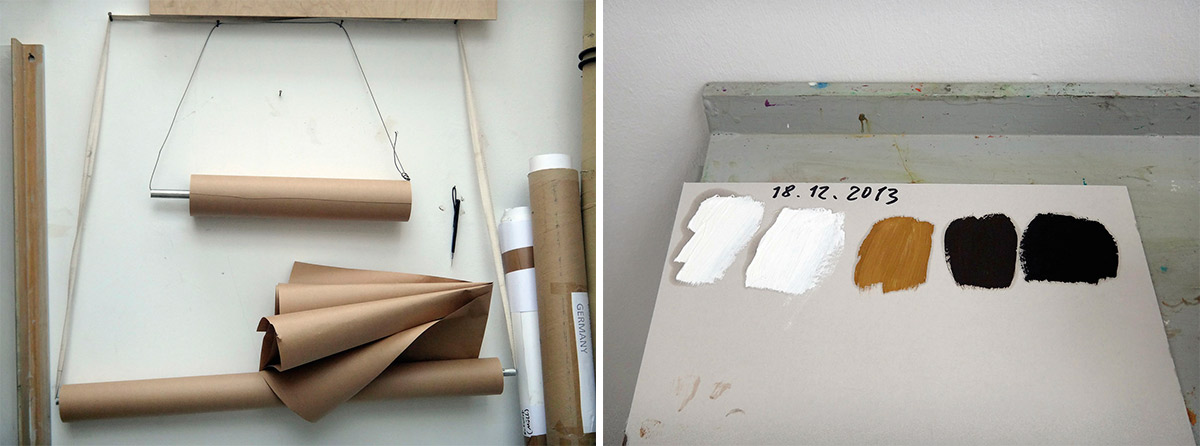
“Quando Gerhard Richter me pediu para visitá-lo em seu ateliê, fiquei estarrecido ao constatar que ele tinha apenas quatro telas em branco para me mostrar: quadros que ainda não haviam sido pintados. Mas compreendi imediatamente que aquilo constituía um objeto fotográfico exemplar para um historiador da arte”, Colônia. Fotos de Georges Didi-Huberman, 2013.
You do not intend to be a photographer in the broad sense of the term, but, in some cases, you publish your own photographs. I think of the dialog you recently had with the painter Gerhard Richter, when you talked in his studio and, later, through correspondence. What was your photographic work and what is its place in your analysis of Richter’s work?
I do not see myself as a photographer, even more so when talking with you, a photography specialist and virtuoso. I consider the photograph from only the two heuristic attitudes of framing and montage, which is not a lot, when we consider the formal aspects of photography in general: grain, lighting, size, orientation, choice of support, etc. Again, photography is for me very close to this intense production of the written file cards. I do not take a photo with the intention of making a beautiful picture at whatever cost, but to achieve a file card that can be related to others. This is part of what Foucault called hypomnèmata, the mnemonic and heuristic tools of thought.
When Gerhard Richter asked me to visit him in his studio, I was astounded to find that he had only four blank canvases to show me: paintings that had yet to be painted. It was a request-to-speak: he wanted to talk freely, floating between topics and, as well, he was a little embarrassed, regarding the issue of Birkenau. But I understood immediately that that empty atelier, with four blank canvases and a piece of metal furniture with three pots of paint, all that was an exemplary photographic object for an art historian. So, I asked Richter when he was about to take a 15-minute nap after the meal if I could stay in the studio and take pictures. My letter, afterwards, was the result of that only outlined conversation and those images of a pictorial job not realized. As usual, I first selected the images and then positioned them in a sequence that, in itself, “said” something – a narrative arrangement, in a certain way –, and from there all that was left for me to do was to write the score of those images and my recollections of that day with the painter.
In addition to the famous sentence which opens the interview, you worked in 2013 within a framework of a cycle of five conferences at the Louvre on the issue of the Album of Art at the Time of the Imaginary Museum in Malraux. What is the importance of the researcher and artist André Malraux in relation to what you establish between photography and art history?
He is important, everyone knows that. His works in The Imaginary Museum are masterpieces of art publishing and influenced that time. But it was a model that I should not follow. The way in which Malraux uses photography of art is prescriptive, encompassing, normative, in addition to his brilliant intuitions. After Walter Benjamin and Warburg, we can, on the contrary, imagine a use of photography in art history that is not illustrative, but hypothetical. Faced with an association between two images, Malraux proposed that it answered questions such as: what is the style that can be deduced from that association? What is art, after all? It seems to me that we can at the same time be more modest (at the metaphysical level) and more operative (in terms of the contact or the contrasts between images), like Georges Bataille, for example, in the extraordinary illustration of his journal Documents. There are crucial bifurcations in the “politics of differences” to adopt when we use photographic images to achieve a more sen- sitive idea of history. ///
Georges Didi-Huberman (1953) is a philosopher, art historian and professor at the School for Advanced Studies in Social Sciences in Paris. He is the author of essays such as Images in Spite of All (2004), The Surviving Image (2002) and Ce que nous voyons, ce qui nous regarde [what we see, who sees us] (1992).
Arno Gisinger (1964) is a French artist, curator and professor at the University of Paris 8.
+
Images in Spite of All, by Georges Didi-Huberman (University of Chicago Press, 2008)
Invention of Hysteria: Charcot and the Photographic Iconography of Salpêtrière, by Georges Didi-Huberman (MIT Press, 2003)
Mnemosyne Atlas, by Aby Warburg (L’Écarquillé, 2012)
captions p. 87: ATLAS. How to Carry the World on One’s Back? Exhibition organized by Georges Didi-Huberman in Hamburg. Photo by Arno Gisinger, 2011. p. 89: Panels dedicated to the roman poet Ovid (43 BC-18 AD), organized by the art historian Aby Warburg (1866-1929). Warburg is best known for his Mnemosyne Atlas, a set of 63 panels with about 1,000 images related by an iconographic logic independent of verbal expression. Warburg Institute, London, 1927. p. 91: In his book Invention of Hysteria, Georges Didi-Huberman studied the relationship between psychiatry and photography in the 19th century, through the iconographic material produced by the Salpêtrière Hospital in Paris, which sheltered women considered crazy or incurable. Under the direction of the physician Jean-Martin Charcot, photography was used as a controversial proof of hysteria. Photograph from the book Iconographique photographique de la Salpêtrière (1876-1877), by Bourneville and régnard. p. 93: Georges Didi-Huberman dedicated his book Images in Spite of All to the only four photographs which document the process of mass extermination in the gas chambers of Nazi concentration camps. The photographs show the burning of bodies, and women entering the chamber in Crematorium 5 in Auschwitz. Taken secretly by a Jewish prisoner forced to participate in the atrocities, these images are an act of resistance, argues Didi-Huberman. Auschwitz-Birkenau Memorial and Museum, Poland, 1944. pp. 94-95: These photographs taken by Marcel Gautherot in Congonhas (known then as Congonhas do Campo), Minas Gerais, c. 1947 (© Coleção Marcel Gautherot/ Instituto Moreira Salles), were included in the exhibition Uprisings, organized by Georges Didi-Huberman and inspired by the visual investigation into gestures, developed by Aby Warburg. p. 96: Photography has been used by Didi-Huberman since the 1980s to make reproductions of works not available in the image banks of French institutions, such as this “false marble” – a detail from the fresco Madonna of the Shadows (c. 1435), by Fra Angelico. Convent of San Marco, Florence. Photo by Georges Didi-Huberman, 1985. p. 98: While walking with friends at Parque Lage in rio de Janeiro, Didi-Huberman observed the tree roots that sprang up like great snakes. Fascinated, he asked himself: “But, after all, what does ‘radicalism’ mean?,” and realized that, “in this case and in many others, the photographic act took place at the exact moment when a sensitive perception encountered a philosophical inquiry.” Photo by Georges Didi-Huberman, 2013. p. 99: Didi-Huberman’s writing is based on a system of filing cards, similar to those used in the practice of photography. Photo by Georges Didi- Huberman, 2009. pp. 100-01: Photographs of the Auschwitz-Birkenau concentration camp, where Didi-Huberman lost relatives. The photographic images are a testament to the historian’s visit to the site and the way he found to describe the emotion he felt. Photo by Georges Didi-Huberman, 2011. p. 102: “When Gerhard richter asked me to visit him in his studio, I was astounded to find that he had only four blank canvases to show me: paintings that had yet to be painted. But I understood immediately that those canvases were a perfect photographic object for an art historian.” Cologne. Photos by Georges Didi-Huberman, 2013.
Tags: Campo de extermínio, Filosofia, História da Arte

